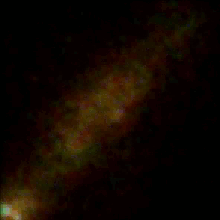Vela pulsar facts for kids

The Vela Pulsar (also known as PSR J0835-4510 or PSR B0833-45) is a super-fast spinning star that sends out beams of energy. We can see these beams as radio waves, light, X-rays, and even powerful gamma rays. This amazing object is found inside the Vela Supernova Remnant, which is the leftover cloud from a huge star explosion. It's located in the constellation called Vela.
Contents
What is a Pulsar?
A pulsar is a type of neutron star. Neutron stars are what's left after a very massive star runs out of fuel and explodes in a supernova. When this happens, the star's core collapses into an incredibly dense object, much smaller than our Sun but with more mass. Imagine squeezing something heavier than the Sun into a ball only about 20 kilometers (12 miles) wide!
These neutron stars spin very quickly. As they spin, they send out beams of radiation, like a lighthouse. If these beams sweep past Earth, we see them as regular pulses, which is why they are called "pulsars."
How Fast Does the Vela Pulsar Spin?
The Vela Pulsar is famous for how fast it spins. It rotates more than 11 times every single second! To be exact, it spins 11.195 times per second. This means one full spin takes only about 89.33 milliseconds. When it was first discovered, it was the fastest spinning pulsar known.
The Vela Supernova Remnant
The Vela Pulsar is connected to the Vela Supernova Remnant. This remnant is a huge, expanding cloud of gas and dust left over from the supernova explosion that created the pulsar. Scientists estimate that this cloud is still moving outwards very quickly, at about 1,200 kilometers (745 miles) per second.
How We See the Vela Pulsar
The Vela Pulsar is one of the brightest objects we can see in the sky when looking for high-energy gamma rays. It's like a super bright flashlight in the gamma-ray part of the sky.
It also has a visible light part, which is the third brightest among all known pulsars. This optical part pulses twice for every single radio pulse it sends out. This difference helps scientists learn more about how pulsars work.
See also
 In Spanish: Púlsar de Vela para niños
In Spanish: Púlsar de Vela para niños

